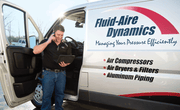Compressed air from a compressor efficiently powers your facility's tools and equipment. When you need a new unit for your operations, you need to understand how to size an air compressor. Determining the correct air compressor size can help minimize downtime and keep your operations efficient, ensuring you select a model that isn't overpowered or too small for your requirements.
6 Things to Consider When Choosing an Air Compressor
Physical size is not the key factor to consider when purchasing an air compressor — a larger compressor isn't necessarily a more powerful one. You should instead evaluate your needs when it comes to:
- Air pressure: Measured in pounds per square inch (PSI), this pressure describes how much air the compressor delivers. Higher PSI measurements mean the unit produces more air volume.
- Air delivery: Expressed in cubic feet per minute (CFM), air delivery shows how much air a compressor can pump in one minute. Air delivery is also known as volume flow rate. The larger your application or the more complex your needs, the higher CFM you'll require.
- Power: Air compressor power considerations include horsepower and the power supply. Horsepower shows how much power the unit's engine provides, and your air compressor power supply options include electric, hydraulic and gas. Electric motors often have simpler maintenance needs, lowering their operating costs. Hydraulic compressors are also cost-effective and can integrate into your existing power sources. Gas-powered models provide consistent pressure.
- Tank size: Short tanks are suitable for intermittent compressor use, often in quick bursts. If you'll continuously use your compressor, you'll need a larger tank that can store more air and keep up with demand.
- Duty cycle: Duty cycles are how often a compressor can run before pressurizing more air. This measure is often expressed as a percentage — a 50% duty cycle would require two minutes to cycle in new air after one minute of operation.
- Configuration and air capacity: Consider your operating needs to determine the air compressor type and capacity you require. For example, reciprocating compressors, available in single-stage and two-stage configurations, have lower capacities, making them well-suited for workshops, construction sites and other needs that require intermittent use. Rotary screw compressors offer higher capacities and are designed to operate continuously, so they are often used in industrial applications.
How to Calculate Air Compressor Requirements
With those factors in mind, you'll need to note a few numbers and make your compressor sizing calculation following these steps:
- Check your tool CFM requirements: Collect the CFM requirements for all the air tools you use at once in your operations.
- Add the CFM requirements: Get the total CFM requirement by adding each tool's CFM together.
- Multiply the CFM: To ensure the air compressor you select can meet your requirements and any potential new tools you add down the line, multiply the total CFM by 1.3 to increase it by 30%.
- Calculate air storage needs: To determine your optimal storage tank size, multiply the CFM you calculated by 5. The result will be the ideal size of your storage tank in gallons.
- Determine max PSI: To evaluate the maximum PSI your tools require, note each pressure required and select the highest one.
How to Choose the Right Air Compressor for Your Needs
After your calculations, you can determine how big of an air compressor you need. To choose among the various air compressor sizes, make these considerations:
1. Air Pressure
Understanding your maximum required operating pressure helps you select a compressor size. You'll typically find air compressors rated between 100 PSI to 175 PSI. The highest PSI requirement for your tools or machinery will determine what you'll select for your air compressor.
2. CFM Requirements
The larger your application, the higher CFM you'll need. By considering all the tools you use at once and increasing their total CFM ratings by 30%, you'll have a buffer that can accommodate factors such as leaks or added tools. Whenever you run more than one air tool or piece of machinery at once, you'll want to ensure the total CFM requirements do not exceed what your compressor can provide.
With your calculated CFM noted, you can compare your air compressor options using standard cubic feet per minute (SCFM). SCFM is the airflow converted to a standard that assumes these conditions:
- 36% humidity at sea level
- 68 degrees Fahrenheit
- 14.5 pounds per square inch absolute (PSIA)
Note that the compressor's CFM rating will be lower than the SCFM calculation. CFM values are measured when the air supply is pressurized — typically at 90 PSI.
3. Horsepower
While larger horsepower (HP) does not always equate to a more powerful compressor, it is a factor worth considering. A higher HP often means the air compressor can power heavy workloads. Air compressors typically range between 1.5 HP and 6.5 HP.
4. Air Capacity and Tank Size
Physical size matters most when it comes to your compressor's tank size. As an industrial operation, your facility will likely require a large tank size. Compressors that have larger tanks and suitable motors provide higher levels of air pressure for sustained periods. Larger tanks require fewer duty cycles, meaning your teams can continue working with little downtime. Because your facility will likely need a larger air compressor tank, keep your space limitations in mind.
5. Duty Cycle
Duty cycles describe a compressor's on-off cycle. Off-time is a momentary drop in pressure when the compressor is recharging. For applications that require bursts of air, off-time is acceptable. Uses that require a constant air pressure, such as painting vehicle parts, need a steady flow and a smaller duty cycle.
For uses that need constant air pressure and industrial applications, a 100% duty cycle is often necessary. These air compressors can work continuously and are often equipped with engine-cooling features to maintain efficient and safe operations.
You may also see the duty cycle described in active-idle time. A 70/30 duty cycle means the compressor is active for 70% of the time it's powered on.
6. Compressor Style
Other than size or air pressure and supply values, you'll have various compressor designs to choose from:
- Oil-free compressors: Choose oil-free air compressors if you require a contaminant-free yet steady power supply.
- Centrifugal compressors: This dynamic air compressor option turns kinetic energy into high air pressure and is suitable for clean environments.
- Rotary screw compressors: Rotary screw compressors are cost-effective and have little maintenance needs, and they're beneficial for 24/7 operations and continuous air needs.
- Reciprocating compressors: Facilities of all sizes can use reciprocating air compressors, and these units can supply more pressure than other models.
- Rotary vane compressors: With their compact design, rotary vane compressors are suitable for smaller spaces with low capacity needs.
- Pressure-lubricated compressors: A pressure-lubricated air compressor provides long-term operation for industries such as aerospace and automotive.
Contact Fluid-Aire Dynamics to Find the Right Air Compressor
Fluid-Aire Dynamics can help you select the right commercial compressor size for your operations. Serving Chicago, Milwaukee, Minneapolis, Detroit and Philadelphia, we are established experts offering a range of air compressor solutions and services. We have helped businesses of varying sizes and industries find the perfect compressor systems for their needs, and we can help yours next.
Browse our air compressors, and call us at 610.913.9100 or contact us online for assistance in choosing the right compressor size.





